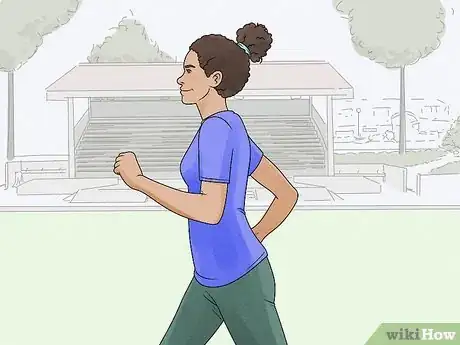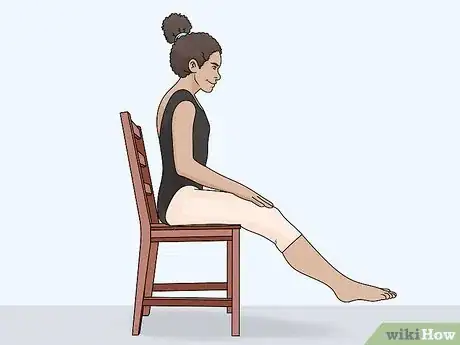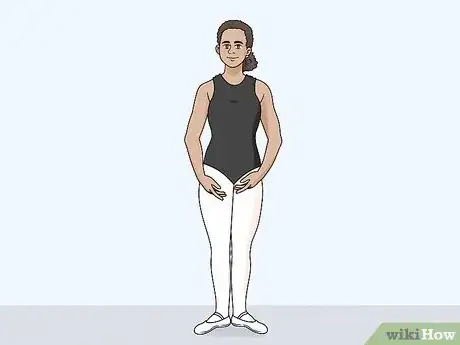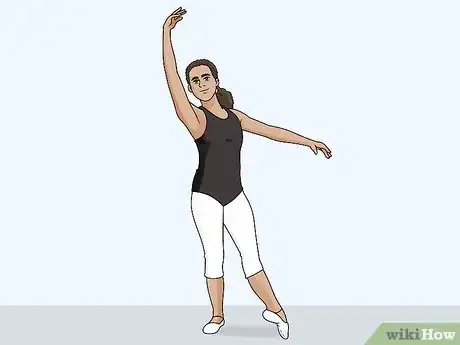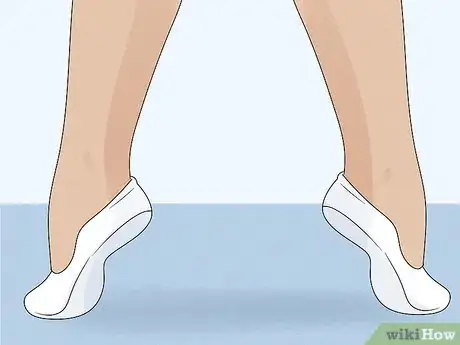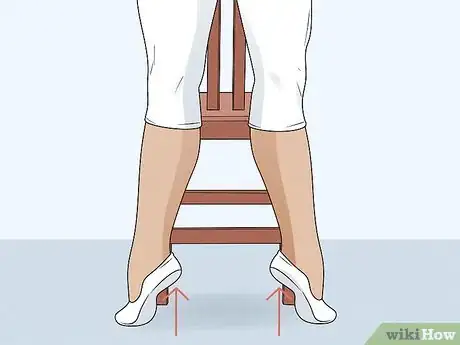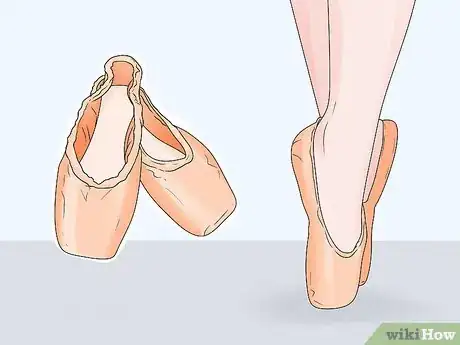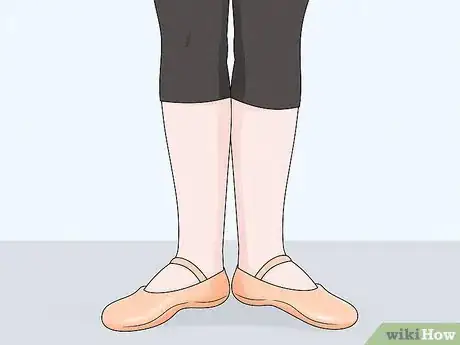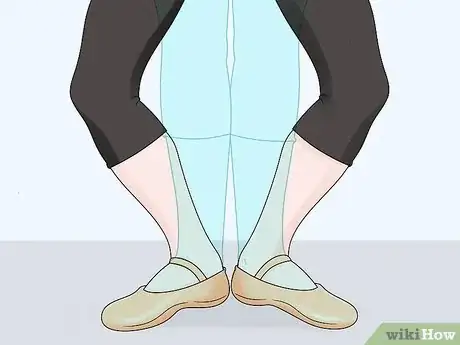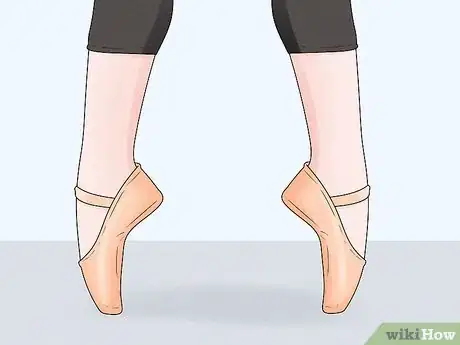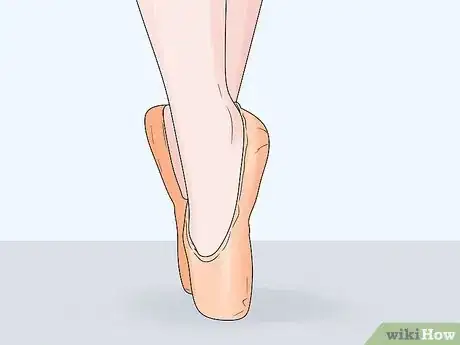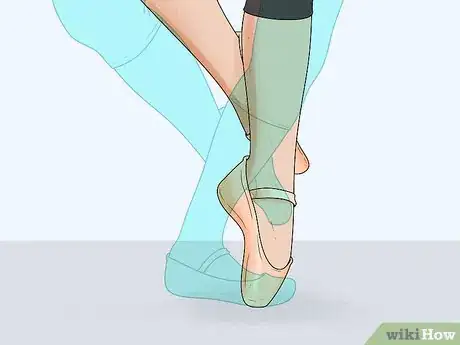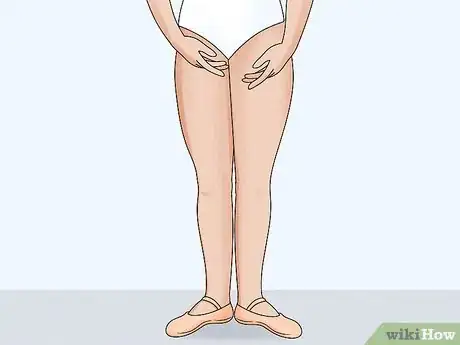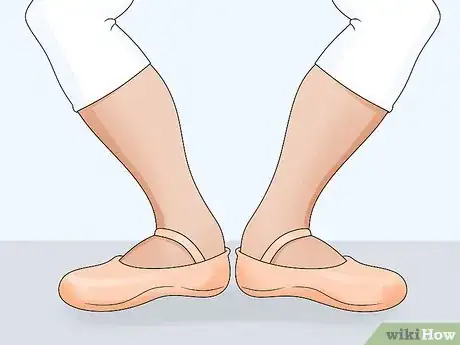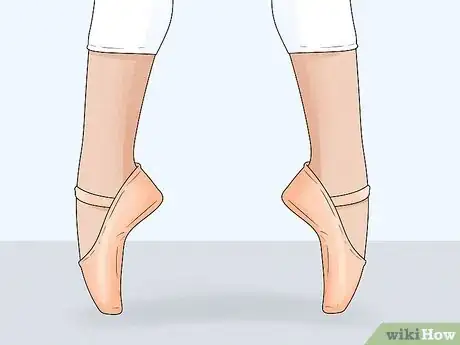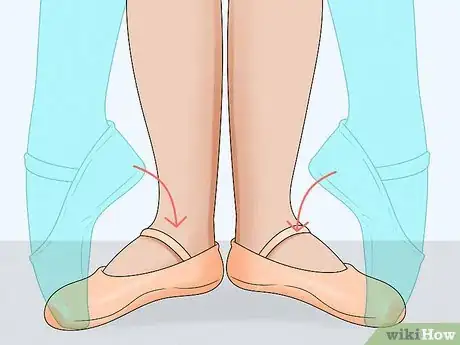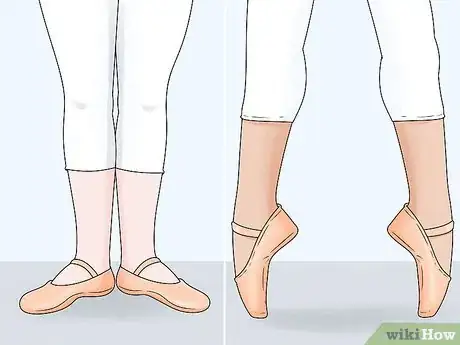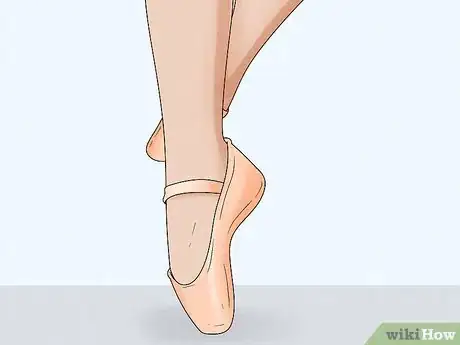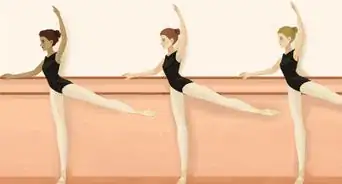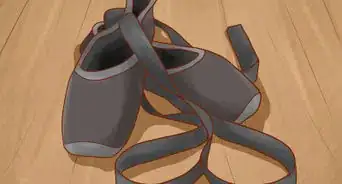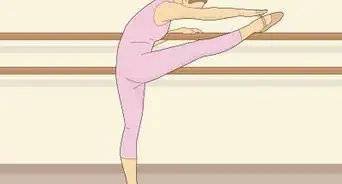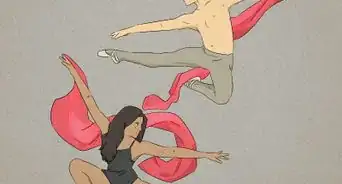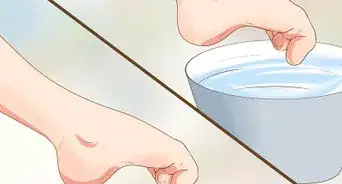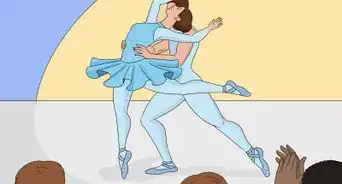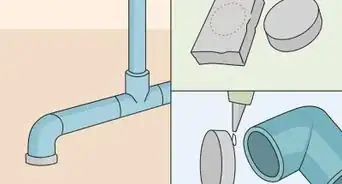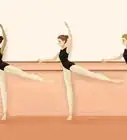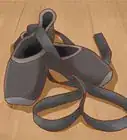This article was co-authored by Geraldine Grace Johns. Geraldine Grace Johns is a Professional Ballerina and the Owner of Grace Ballet in New York and Los Angeles. Geraldine toured through New Zealand, Australia, Japan, and Korea as Jammes in Ken Hill's Original Phantom of the Opera. She has studied with the Royal Academy of Dance in London to become a teacher and taught for the Kudo School of Ballet in Yokohama. Geraldine also ran her own Royal Academy of Dance School in New Zealand before studying at the Neighborhood Playhouse School of the Theatre in New York City. Geraldine was a guest coach and Master Class teacher in Toronto for the Canadian Royal Academy of Dance's Dance Challenge in 2018, 2019, and 2020. She was also a guest coach and Master Class teacher for the USA Royal Academy of Dance Challenge in Long Beach, California in 2019 and 2020. Grace Ballet Los Angeles has won recognition as one of 13 Best Ballet Schools in Los Angeles since opening her school. Geraldine is a contract Practical Teaching Supervisor for the Certificate in Ballet Teaching Studies for the Royal Academy of Dance.
There are 7 references cited in this article, which can be found at the bottom of the page.
This article has been viewed 23,231 times.
To do a relevé, you must rise up on the pointe or demi-pointe from flat feet often using a little spring from a demi-plié, during which both feet are swiftly drawn up.[1] Relevés are a part of basic ballet and are very important while doing many dancing tricks and turns. They are pretty simple if done in the right way. Read on to learn how to do one!
Steps
Getting Ready Before Practicing
-
1Stay physically fit. Before doing any tricks, even if it is a small relevé, you must be fit and healthy. Exercise for at least 30 minutes a day, and work hard towards keeping yourself in good health.[2]
- You must be able to lift your weight with your legs while doing a relevé. Try standing on your toes and walking around for a while until you get comfortable with it.
-
2Warm-up before dancing. To prevent yourself from getting hurt or making your muscles tire out, warm up. Since relevés base on your ankles and feet, you must make sure they are strong, and wouldn't damage if you do relevés.[3]
- If your ankle has been damaged before, be more careful as you wouldn't like to injure yourself again.
- Keep pointing and flexing your feet as an exercise. Every chance you get, sit down, stretch your legs and point them for a few seconds, and bring them further back. Keep doing this to strengthen your feet.
Advertisement -
3Learn the different ballet positions. There are five different foot positions in ballet, and it's best if you know the basic positions before moving ahead with the rest.[4]
- To become better at dancing, it is suggested that you learn the five different foot positions in ballet as a start. This will help you grow into a better dancer, and will make you further familiar with dancing.
-
4Find the perfect shoes. If you are a beginner, it's best if you use canvas or leather shoes while dancing. While learning how to do a relevé, wear socks, or practice barefoot.[5]
- Do not start with pointes as they can heavily damage your ankles without the right training.
Doing the Relevé
-
1Begin in the first position. While doing the first position, your feet must be in a "V" shape. Try to keep your legs turned out as close to 180 degrees as you can manage.
- Keep your back straight, as it's important to maintain your posture while dancing.
- Try to keep your legs straight as well, without bending your knees.
- Since a wider turn comes only with practice, it's best if you do not strain yourself to make it 180 degrees.
-
2Fix your posture a bit more. Make sure your legs are externally rotated and your weight is even. Hold your spine long and tall, and keep your arms slightly rounded, relaxed, and low in front of your body.[6]
- Position your chin a bit upwards, and push your shoulders back, too.
-
3Stand on your toes. Press through the heels of your feet, and pull them up to stand on your toes. Try to stay there for a few seconds, and place your heels gently back down again. Focus on keeping your legs strong, straight, and externally rotated. Engage your core and keep your shoulders lifted and back.
- Make sure that you're leveling your weight balance and that you're not on your big toe or your little-toe too much.
- Make sure that your heels are turned in, and they are in level.
- During a relevé, focus on engaging your core; having your turnout; controlling and engaging your inner thighs, bottom, and hips; and pulling your knees up.[7]
-
4Rise slowly with grace. As your rise, try to keep your back straight, and keep your arms relaxed, but in the correct position.
- To maintain balance, try holding something to give you support such as a chair or a barre. As you practice further, release your grip from the chair and try again.
- Continue to keep your head up and bottom tucked while rising.
-
5Return to the first position. To finish your relevé, come back to the first position, which is the same position you were in before doing the relevé.
- You can also move into other positions after doing the releve, but it's best to come back to the first position if you're just practicing.
Doing the Relevé on Pointes
-
1Follow precautions. Using pointes is dangerous, and shouldn't be used without intense training or instructions from your trainer. They can injure your muscles and tissues, and can cause serious damage to your ankles. Unless you are instructed, it's best if you refrain from using pointes.[8]
-
2Begin in the first position. You can do relevés from different ballet positions, but it is easiest to start in the first position. Your feet must be turned out with your heels touching, and your legs straight.
- Make sure that your knees aren't touching each other.
-
3Descend into a demi-plié. You must bend your knees halfway, with the legs turned out from the hips and the knees open.
- Make sure your back is straight, and hold on to something for support, especially since you're on your pointes.
- Do not stand on your toes while doing the plie.
-
4Rise gracefully. Make sure that you keep the weight on balls of your feet as you lift up your heels. Your feet should still be turned out. Slowly rise to the tips of your pointes after doing your demi-pliés. Maintain strength in your quadriceps and calves.
- Immediately get back to your heels if you sense any pain in your toes, feet, or ankles.
-
5Return to the position that you started in. If you're just practicing basic relevés on pointe, you must return to the same position that you started in. If you get further comfortable with relevés, you can start doing other tricks and turns right after doing your relevé on pointe.
-
6Practice relevés from other positions. Once you feel comfortable with the relevé in first position, try to do it from the other four positions as well.
- It gets harder as you try in different positions, especially from the fifth position in pointe. Keep practicing with patience until you are comfortable with doing a relevé starting with every different position.
Doing a Relevé with a Spring
-
1Understand the difference between a usual relevé and a spring relevé. Both the relevés refer to lifting yourself up high on your toes, and both can be done in all five ballet positions. The major difference between the two is that you don't have to bend your knees in a usual relevé but you must when you do a spring one, as it gives more momentum.
-
2Start with the first position. Start again with the first position as it's the most common training position for beginners.
- As you get comfortable with starting from the first position, you can proceed to try it from other positions as well.
-
3Do a pile. After starting in first position, bend your knees into a pile. Bending your knees makes it a spring point which helps you get further on your toes, and pushes you higher up.
- When you bend, make sure that you're not lifting your heels up. Keep your feet in the position that you started in, glued to the ground.
-
4Rise with your feet a bit further from each other. When you stand on your toes, move your heels in a bit, almost facing each other.
- Remember to balance the weight equally. Make sure you don't put way too much weight on your first or last toe.
-
5Come back to the first position. As always, you must finish where you started when you're practicing dancing.
- If you want to go one step further, you can do a split jump or a few tricks as well.
-
6Practice rising gracefully. While dancing, you must make sure that you're stable and your movements aren't jerky. This can take a lot of practice, but it's worth it in the end.
-
7Practice spring releves from other positions. Once you feel comfortable performing spring releves from the first position, you should begin practicing them from the other starting positions as well.
Expert Q&A
-
QuestionWhat is a relevé?
 Geraldine Grace JohnsGeraldine Grace Johns is a Professional Ballerina and the Owner of Grace Ballet in New York and Los Angeles. Geraldine toured through New Zealand, Australia, Japan, and Korea as Jammes in Ken Hill's Original Phantom of the Opera. She has studied with the Royal Academy of Dance in London to become a teacher and taught for the Kudo School of Ballet in Yokohama. Geraldine also ran her own Royal Academy of Dance School in New Zealand before studying at the Neighborhood Playhouse School of the Theatre in New York City. Geraldine was a guest coach and Master Class teacher in Toronto for the Canadian Royal Academy of Dance's Dance Challenge in 2018, 2019, and 2020. She was also a guest coach and Master Class teacher for the USA Royal Academy of Dance Challenge in Long Beach, California in 2019 and 2020. Grace Ballet Los Angeles has won recognition as one of 13 Best Ballet Schools in Los Angeles since opening her school. Geraldine is a contract Practical Teaching Supervisor for the Certificate in Ballet Teaching Studies for the Royal Academy of Dance.
Geraldine Grace JohnsGeraldine Grace Johns is a Professional Ballerina and the Owner of Grace Ballet in New York and Los Angeles. Geraldine toured through New Zealand, Australia, Japan, and Korea as Jammes in Ken Hill's Original Phantom of the Opera. She has studied with the Royal Academy of Dance in London to become a teacher and taught for the Kudo School of Ballet in Yokohama. Geraldine also ran her own Royal Academy of Dance School in New Zealand before studying at the Neighborhood Playhouse School of the Theatre in New York City. Geraldine was a guest coach and Master Class teacher in Toronto for the Canadian Royal Academy of Dance's Dance Challenge in 2018, 2019, and 2020. She was also a guest coach and Master Class teacher for the USA Royal Academy of Dance Challenge in Long Beach, California in 2019 and 2020. Grace Ballet Los Angeles has won recognition as one of 13 Best Ballet Schools in Los Angeles since opening her school. Geraldine is a contract Practical Teaching Supervisor for the Certificate in Ballet Teaching Studies for the Royal Academy of Dance.
Professional Ballerina & Ballet Instructor A relevé is a raised action where you are on a high demi pointe or full pointe. You begin with a demi plie and quickly draw or snatch your feet underneath by replacing your toes where your heels were. As you do this, remain on either demi or full pointe.
A relevé is a raised action where you are on a high demi pointe or full pointe. You begin with a demi plie and quickly draw or snatch your feet underneath by replacing your toes where your heels were. As you do this, remain on either demi or full pointe. -
QuestionWhat can I do if my releves are not too high?
 BrookeCommunity AnswerPractice. Practice makes perfect, and you must keep practicing hard. Exercise your toes regularly, and walk on them for a particularly long time, increasing a minute longer than the last. If you can walk around on your toes for 3 minutes today, try to achieve 4 minutes tomorrow! Most importantly, never give up. If you cannot do it for too long, rest, and try again. You'll surely do well!
BrookeCommunity AnswerPractice. Practice makes perfect, and you must keep practicing hard. Exercise your toes regularly, and walk on them for a particularly long time, increasing a minute longer than the last. If you can walk around on your toes for 3 minutes today, try to achieve 4 minutes tomorrow! Most importantly, never give up. If you cannot do it for too long, rest, and try again. You'll surely do well! -
QuestionI've been dancing for 4 years. I am eight, but how can I improve?
 BrookeCommunity AnswerYou're eight, and you've been dancing since you were four, that's excellent! Since you are young, try making your body more flexible. Although flexibility in dancing is not everything, being flexible and doing several tricks and turns comes in handy for competitions and events. Practice your turns, especially your fouettes and pirouettes. If you're a jazz, ballet, contemporary, or mixed dancer, get training from a professional. They know what's right for you, and can detect your strengths and weaknesses.
BrookeCommunity AnswerYou're eight, and you've been dancing since you were four, that's excellent! Since you are young, try making your body more flexible. Although flexibility in dancing is not everything, being flexible and doing several tricks and turns comes in handy for competitions and events. Practice your turns, especially your fouettes and pirouettes. If you're a jazz, ballet, contemporary, or mixed dancer, get training from a professional. They know what's right for you, and can detect your strengths and weaknesses.
References
- ↑ Geraldine Grace Johns. Professional Ballerina & Ballet Instructor. Expert Interview. 20 May 2021.
- ↑ https://www.shape.com/celebrities/celebrity-workouts/lean-body-tips-professional-dancers
- ↑ https://www.jadeharrisonschoolofdance.co.uk/index.php/about/blog/106-the-benefits-of-a-dance-warm-up
- ↑ https://www.tututix.com/ballet-terms-beginners/#:~:text=As%20BalletHub%20noted%3A,of%20the%20five%20basic%20positions.%E2%80%9D
- ↑ https://thelegacydancestudio.com/importance-wearing-proper-dance-attire-shoes-dance-class/
- ↑ https://www.bodyzone.com/importance-of-posture-in-dance/#:~:text=Dancers%20should%20strive%20for%20a,for%20injury%20and%20maximize%20function.
- ↑ Geraldine Grace Johns. Professional Ballerina & Ballet Instructor. Expert Interview. 20 May 2021.
- ↑ https://www.ortho.wustl.edu/content/Patient-Care/3496/Services/Physical-Medicine-and-Rehabilitation/Performing-Arts-Program/Criteria-for-Pointe-Work.aspx#:~:text=The%20student%20must%20be%20at%20least%2011%20years%20old.&text=The%20bones%20of%20the%20feet,can%20permanently%20damage%20immature%20bones.

